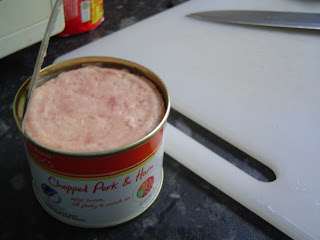It took a while for Sainsbury's to come up with a Basics version of chopped pork and ham, but its introduction would tie in pretty nicely with the overall theme of this blog. No supermarket in the UK stocks rice vermicelli though, so to compensate I will probably cook three packs of Basics chicken flavour instant noodles. Incidentally, doing this is popular in Hong Kong, where time-poor residents can even go to cafes which serve instant noodles with luncheon meat and egg. To assuage my mother's concerns about my diet I will cook up some spinach to go with it too.
The gelatin you see on the block of pork comes from the bottom of the can. I remembered having the luncheon meat in semi-circular slices, so I did the same. Half a can of the luncheon meat would be enough for one person, according to Sainsbury's nutritional guidelines anyway. The other half could be saved for something else, like fried rice.
Pan-fry the slices until golden brown.
Cook the instant noodles while frying an egg sunny-side up.
When fried to a crisp, the Basics chopped pork and ham tastes more like bacon than the luncheon meat I'm familiar with, possibly due to differences in the meat itself. The cost breakdown of the meal is: 50p for half a can of meat; 12p for a Basics egg; 30p for 3 packs of instant noodles, and; a variable cost for vegetables depending on what you add. Replacing the instant noodles with pasta would probably lower the overall cost of eating this. Still, it's good to know that when homesick and the nearest Chinatown is inaccessible, one can still turn to Sainsbury's to be reminded of home.
| Description | Price per Unit | No. of servings | Trade-up Premium | Trade-up Benefits |
|---|---|---|---|---|
| Chopped Pork and Ham | £0.99/kg | 200g | +£0.30 | Higher meat content. |
























